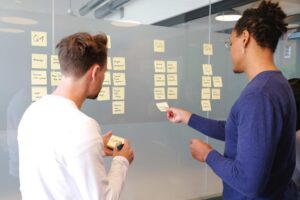Exploring The 7 Principles of Lean Software Development
Lean software development refers to the application of Lean principles to the realm of software creation. Originally derived from the manufacturing sector, these principles aimed to enhance the production line by reducing waste and delivering maximum value to the end customer.
In the context of software development, these objectives remain highly relevant as it also involves following a repeatable process, adhering to specific quality standards, and relying on collaborative efforts among a group of specialised professionals. Despite these commonalities, it is essential to acknowledge significant distinctions between manufacturing and software development.
What is Lean Software Development?

Lean software development revolves around the central idea of maximising efficiency and reducing waste during the software development process. Its origins trace back to the Lean manufacturing movement that emerged in the 1980s. Over time, it has evolved to become an essential component of the Agile software development methodology. Moreover, the principles of Lean thinking extend beyond software development and can be effectively applied in various other disciplines. An illustration of this is Lean management, which adopts similar Lean principles to enhance efficiency and value in different contexts.
The 7 Principles of Lean Software Development?
The software development process can be effectively guided by the Lean development methodology, which draws its foundations from Lean manufacturing. To elucidate these principles, we can refer to seven key Lean principles adapted from Mary and Tom Poppendieck:
- Specify Value: Understand and define the specific value that the software product intends to deliver to the end-users or customers.
- Identify the Value Stream: Map out the entire value stream, encompassing all the steps and processes involved in delivering the software, from concept to deployment.
- Establish Flow: Enable a smooth and continuous flow of work through the development process, reducing bottlenecks and delays.
- Implement Pull: Emphasize a pull-based system, where tasks are pulled by the development team based on their capacity and readiness to work on them.
- Seek Perfection: Continuously strive for improvement in the development process, aiming for perfection in delivering value to customers.
- Embrace Empowerment: Encourage a culture of empowerment and collaboration within the development team to foster creativity and efficiency.
- Optimize the Whole: Focus on optimising the entire software development process as a whole, rather than just individual steps or components.
Eliminate Waste
In Lean engineering, the core principle revolves around considering anything that fails to enhance the product’s value as waste. The determination of a product’s value is based on the client’s perspective. The primary objective of waste reduction, the first tenet of Lean engineering, is to eliminate or minimise nine specific types of waste, which include:
- Unnecessary features and code
- Excessive tasks in the backlog that exceed capacity
- Delays in the engineering process
- Ambiguous or vague requirements
- Inefficient communication
- Issues with product quality
- Unneeded and burdensome bureaucracy
- Data duplications
- Costs associated with the aforementioned waste
To achieve waste reduction, Lean development practices involve holding regular meetings after each short iteration, where project managers and team members come together. These meetings serve as a platform to identify and eliminate waste, monitor progress, identify bottlenecks, and gather valuable insights for implementing changes in subsequent iterations.
The approach fosters a learning environment, enabling code modifications to be carried out in small, manageable steps. This iterative process empowers the team to continually improve and optimise the software development process.
You can learn more about creating great requirements from user stories by clicking here.
High Build Quality
Achieving a harmonious balance between application functionality, reliability, and economic value for the company’s clients is crucial for ensuring the quality and consistency of the final product. Consistency encompasses various elements, such as the architecture’s quality (ease of maintenance and extension), customer satisfaction upon delivery and long-term usage, and the overall usability of the application. To maintain this level of quality, Lean employs diverse approaches and practices in custom software development, including Lean development methodologies that prioritise flexibility.
In the Lean approach, the development process involves continuous small iterations or loops, followed by immediate evaluations. The aim is to minimise the gaps between software development phases, engaging in regular discussions and considering trade-offs, which may involve temporary sacrifices in terms of time, costs, or scope.
To proactively address potential issues and ensure software quality, Lean employs techniques like Pair Programming and Test-driven Development. Pair Programming involves two developers working together on each task, leveraging their unique experiences to devise smarter solutions, anticipate challenges early on, and deliver higher-quality outcomes than individuals working independently.
On the other hand, Test-driven Development reverses the traditional “build, then examine” approach. Tests are written before the code is developed, allowing engineers to anticipate and account for all possible outcomes during the development process. This proactive testing ensures that bugs are identified and resolved before they can impact the final product, enhancing overall software quality.
Prioritise Learning

Software development is inherently a learning process. Each new project involves understanding the intricacies of a different organisation and the unique rules that govern its business, for which the application is being created. Obtaining valuable feedback becomes paramount in such scenarios. To achieve this, the use of frequent and short iterations in the development process proves highly effective. These iterative cycles culminate in the implementation of newly created features or functionalities.
By adopting this approach, when the N-th iteration introduces new functionality, we can promptly gather feedback from the client. This feedback becomes instrumental in verifying the accuracy of the knowledge we have acquired about the organisation and its requirements. Additionally, it allows us to ensure whether the application meets the client’s expectations as intended. Embracing this iterative feedback loop ensures that the software evolves and improves continuously based on real-world insights and client inputs.
Postpone Decision Making
During the software development process, the team faces critical choices regarding technology selection, database integration, and the underlying architectures and frameworks for the final product. However, in many instances, there may be insufficient knowledge to make well-informed decisions and confidently proceed down a specific path. In accordance with Lean principles, it is advisable to defer these choices for as long as possible while ensuring that the software remains adaptable to accommodate changes that may arise from the final decision.
In essence, embracing this approach of postponing commitments allows ample room for improvement by delaying irreversible decisions until comprehensive experimentation has been conducted and a substantial amount of information has been gathered. This iterative and flexible method ensures that the software is developed in a way that can readily accommodate modifications, fostering adaptability and optimisation throughout the development journey.
Quick Deliverables
The speed of responsiveness to a client’s needs serves as a key indicator of an IT company’s maturity and reliability. To enhance this aspect, it is advisable to adopt a strategy of delivering the product rapidly and in small increments through individual iterations. By doing so, the client can promptly assess each implemented part of the product, determining if it aligns with their expectations or if any misunderstandings in the customer’s requirements occurred. This approach mitigates the risk of encountering significant changes in customer demands later in the development process, thereby avoiding potential challenges and ensuring a smoother development journey.
Respect
An outstanding team is one that can self-organise, making it essential to grant them the authority to determine roles and responsibilities within the group. The team’s committed members represent its most significant asset, and it is crucial to enable individuals who add value to utilise their full potential while providing them with the necessary support. Striking the right balance between fostering a cooperative atmosphere and maintaining appropriate project control can be challenging.
Developers should have the freedom to make decisions aligned with their expertise, but they must also be accountable for informing the client and managers about their choices. As the client, you have the authority to determine whether these decisions are acceptable and align with your project goals. Encouraging autonomy while maintaining transparent communication empowers the team to flourish and delivers the best possible results.
Optimize
Seeing the product as a cohesive whole is crucial, and this perspective should be shared by all team members involved in its creation. Striving for a well-balanced approach is essential, ensuring that technological solutions and opportunities are carefully weighed and integrated. It is vital to steer clear of optimising specific parts of the system’s functionality at the detriment of the overall product. Instead, the focus should be on achieving harmony and coherence across all aspects of the system to deliver a robust and unified final product.
What are the Benefits of Lean Software Development?

Lean offers several advantages, including:
- Collaboration: Lean principles foster a culture of learning and respect, promoting collaboration and knowledge sharing while preventing bottlenecks. Teams are empowered to make decisions collectively, enhancing the overall decision-making process.
- Continuous Improvement: Lean encompasses a modern software development process that involves constant communication with customers and regular feedback. This emphasis on continuous improvement, also known as Kaizen, applies to all aspects of the operation.
- Efficiency: With the increasing demand for software, organisations face pressure to deliver applications quickly. The Lean approach eliminates waste and streamlines the software development process, leading to improved efficiency and cost reduction.
- Flexibility: Despite prioritising speed, Lean methodology embraces flexibility in the software development lifecycle. It allows for adjustments and modifications based on continuous feedback, enabling teams to adapt to changing requirements.
- Quality: By leveraging the efficiency, continuous improvement, flexibility, and collaboration, Lean results in an overall enhancement in product quality and an increase in customer satisfaction. This emphasis on delivering value ensures that the final product meets or exceeds customer expectations.
What are the Challenges of Lean Software Development?
The success of the framework heavily relies on the capabilities and expertise of the team involved, which can make it less scalable compared to other frameworks. Moreover, it demands strong and comprehensive documentation, and neglecting this aspect may lead to errors and inefficiencies.
Lean Terminology
Let’s take a closer look at the key terminologies associated with lean practices. You can learn more about the terminology used in agile here.
Lean Thinking

The philosophy of Lean thinking originated in the manufacturing sector during the 1950s as a response to the traditional waterfall project management and linear production methods. Its success in manufacturing paved the way for its adoption in other domains, including management techniques and software development. This evolution led to the creation of various Lean disciplines, such as Lean development, Lean management, Lean UX, and Lean startup.
At its core, lean thinking aims to deliver value to clients more efficiently, reducing waste and maintaining high-quality results in a shorter timeframe. It revolves around implementing a well-structured process that ensures value is preserved throughout the product’s delivery cycle while also nurturing team morale.
Lean embodies a mindset that prioritises continuous learning, creativity, and adaptability. Rooted in core beliefs and values, these principles can be applied with proven tools and approaches to achieve specific objectives, depending on the organisation’s or individual manager’s goals. Embracing Lean principles enables organisations to foster innovation, improve efficiency, and adapt to dynamic challenges effectively.
Lean Principles
The Lean principles discussed earlier serve as the fundamental basis for various Lean methods, including Lean startup, Lean UX, and software development. To apply these principles effectively, it is essential to consider the customer’s perspective and define value based on what the client is willing to pay for. Development teams rely on qualitative and quantitative research to determine this value.
The subsequent step involves mapping the value stream and transforming the identified value into measurable objectives for the team to pursue. This process helps outline all the current phases involved in conceiving and delivering a feature or update once the original value is established as a tangible goal. By studying these phases and using flowcharts, teams can identify bottlenecks, pain points, and delays in their delivery process, thus enabling them to achieve a smooth and continuous flow.
Flow improvement becomes crucial at this stage, where the team focuses on detecting and reducing bottlenecks and inefficiencies to facilitate quicker feature production. Once the flow is established, the team operates on a “pull” system, concentrating on projects based on actual client demand rather than relying solely on market and competition projections.
Ultimately, the pursuit of perfection involves iterating through the process multiple times, following the steps of determining value, mapping value streams, eliminating wasteful activities, and implementing flow and pull systems. This iterative approach aims to achieve the highest possible level of profit without generating any waste, leading to continuous improvement and optimisation.
Lean Development
The values in Lean software development may vary depending on the specific job, but they are still firmly based on the underlying Lean principles. In contrast, Lean development focuses on both the technical and human aspects of the project. As we have already discussed the 7 established Lean software development principles for creating more efficient products, we will refrain from duplicating them here.
Lean Startup
Lastly, we have the Lean startup, a methodology introduced by Eric Ries in his book “The Lean Startup,” published in 2011. Primarily tailored for new product development teams and startups in the early stages of their lifecycle, this approach seeks to validate the initial assumptions made by these ventures. The focus is on ensuring that the product being developed effectively addresses real user problems. Emphasizing learning over constant delivery, this strategy is deemed critical for the long-term success of product teams working under the Lean startup framework.
Lean Development Vs Agile Methodologies
Lean and Agile principles share many commonalities, and experts often highlight their similarities rather than their differences. They seamlessly complement each other to the extent that they are sometimes referred to collectively as Lean-Agile.
The last three Lean principles exemplify some of the shared aspects between Lean and Agile. In both approaches, the product development team takes charge of setting the pace and delivering the product. Agile teams achieve this through the sprint methodology, while Lean’s “optimising the whole” principle aligns with the Agile retrospective, where team members gather to discuss successes and challenges upon project completion.
Despite these strong resemblances, there are subtle distinctions between the two processes. Lean places a primary focus on building better processes, while Agile is geared towards creating superior products that meet consumer needs and expectations. Lean serves as one of several Agile frameworks, alongside Scrum and Kanban, which are detailed in the Agile Manifesto. This manifesto outlines a set of values and principles that underpin various Agile methodologies.
How Should I Choose a Development Methodology For My Team?

The decision on which methodology to adopt for ensuring success in your unique team is not a straightforward one, as each team is different, and there is no one-size-fits-all approach. Rather than choosing one over the other, many organisations opt for a combination of both Agile and Lean practices. The key is to honestly evaluate your team’s strengths and weaknesses and incorporate elements from both methodologies that complement and challenge you in the best possible way.
First, capture the basics of your project, such as its criticality to the business, the scope of effort, budget and resource constraints, delivery timeline, and team size. Projects that are wide in scope with resource limitations but have ample time for delivery might benefit from Lean methods, optimising costs and reducing waste. Conversely, projects that are business-critical, limited in scope, and require rapid delivery could be better suited to Agile methods, focusing on rapid iterations based on user feedback. Team size also plays a role, with Scrum teams typically consisting of three to six members, while Lean teams can be larger.
Next, consider your team, customer, and organisation, and rank the following factors from one to ten based on their competency or importance. Factors include the development team’s competence, communication skills, understanding of the customer problem, criticality of customer collaboration, customer urgency, organisational culture, management style, and flexibility to change. If your scores are high in areas like team communication, customer collaboration, urgency, and organisational flexibility to change, Agile methods may complement your existing practices. On the other hand, if you scored high in your team’s understanding of the customer problem and organisational discipline, Lean methods may further optimise your approach.
Visualize your findings through a SWOT analysis, mapping your team’s strengths, weaknesses, opportunities, and threats to success based on the evaluation above. This exercise should not be a one-time effort, as your team evolves and matures. Regularly update the SWOT analysis to reflect your current capabilities and areas for improvement, making it an integral part of your team’s workflow to promote transparency and accountability. By utilising this decision-making process, you can tailor your methodology to suit your team’s unique needs and objectives effectively.
Lean Audit Checklist
The Lean audit checklist serves as a valuable tool to assess the implementation progress of Lean principles within your facility. By utilising this checklist, you can identify the strengths and areas that require improvement. Subsequently, an action plan can be devised and executed to enhance Lean practices. The checklist adopts a six-dimensional model, encompassing leadership, support systems, value stream, continuous improvement, lean techniques, and standard work.
Conducting Lean audits on a periodic basis, such as annually, or as needed, allows you to maintain a clear understanding of your facility’s Lean journey and make targeted improvements accordingly. Through regular evaluations using this comprehensive checklist, you can foster a continuous improvement culture and ensure the sustained advancement of Lean practices within your organisation.
Lean Audit Checklist PDF
You can view our lean checklist as a PDF here.
Lean Audit Checklist Excel
You can view our lean checklist as an Excel document here.
Lean Audit Checklist Doc
You can view the lean checklist as a document here.
FAQ
What is the Meaning of Lean Development?
Lean software development is a philosophy that prioritises efficiency and waste reduction in the software development process. It traces its origins back to the Lean manufacturing movement of the 1980s. Over time, it has become an essential component of the Agile software development methodology.
How Does Lean Development Work?
Lean development revolves around a fundamental concept: Create a simple solution, present it to customers, and then continuously improve it based on their feedback. This iterative approach is particularly crucial in software development, where rapid time-to-market provides a significant competitive edge.
What Are The 5 Lean Principles?
The five principles serve as a recipe for enhancing workplace efficiency and encompass: 1) Defining Value, 2) Mapping the Value Stream, 3) Creating Flow, 4) Implementing a Pull System, and 5) Pursuing Perfection.
What is the Difference Between Lean and Agile?
Lean and Agile are distinct management methodologies, each with its unique focus and objectives. Lean concentrates on eradicating wasted time and resources by thoroughly analysing processes and value streams. On the other hand, Agile serves as an umbrella term for a philosophical approach to software development that emphasises early and continuous delivery of valuable functionality that meets customer needs and expectations. Both methodologies play crucial roles in optimising development practices and delivering high-quality products efficiently.
You can learn more about the Agile methodologies in our guide here.
Overview
Lean development is a potent and efficient approach to software development, placing a strong emphasis on efficiency, continuous improvement, and delivering value to customers. Through the reduction of waste, optimisation of processes, and the cultivation of a collaborative culture, organisations can achieve faster, more cost-effective, and customer-centric outcomes in their software development endeavours.
Now that you understand the concept of lean software development, check out our guide to creating user personas for agile and also see our tips for estimating your project well.
If you’ve enjoyed this post, we’d recommend diving into the following other posts in this Agile series:
- An Introduction to The Agile Methodology
- Themes, Epics and User Stories – The Core Components Of Agile
- Embracing Agile Team Dynamics
- What is SAFe Agile and Why Should I Use It?
- What is Waterfall Development?
- What is Lean Development?
- What is Scrum?
- A Deep Dive Into Epics
- Exploring The Power of User Stories
- How Can I Use Personas?
- Decoding Agile Estimation (Story Pointing)
- Agile Transformation: How Can My Business Start Using Agile?
- The Spotify Approach To Agile Development
- What Is Agile Portfolio Management?
- Agile Glossary
- Agile Statistics







